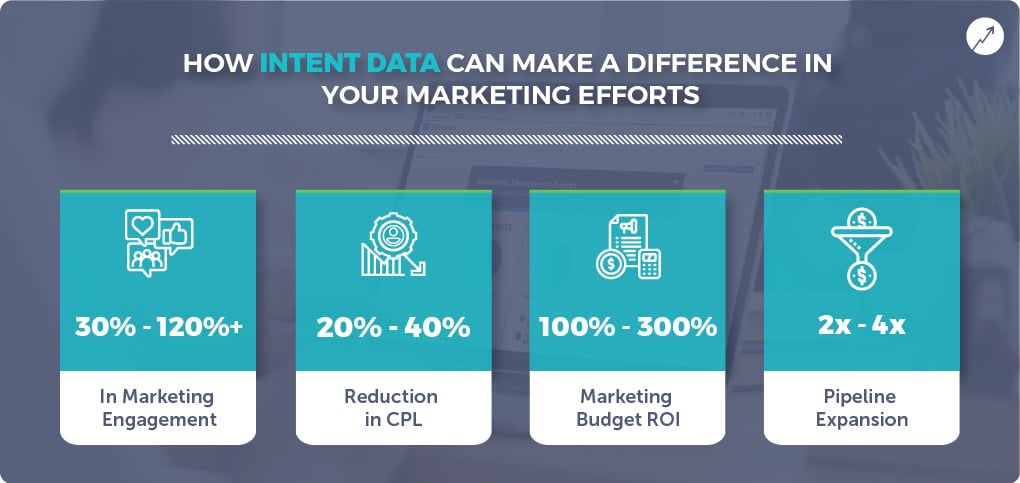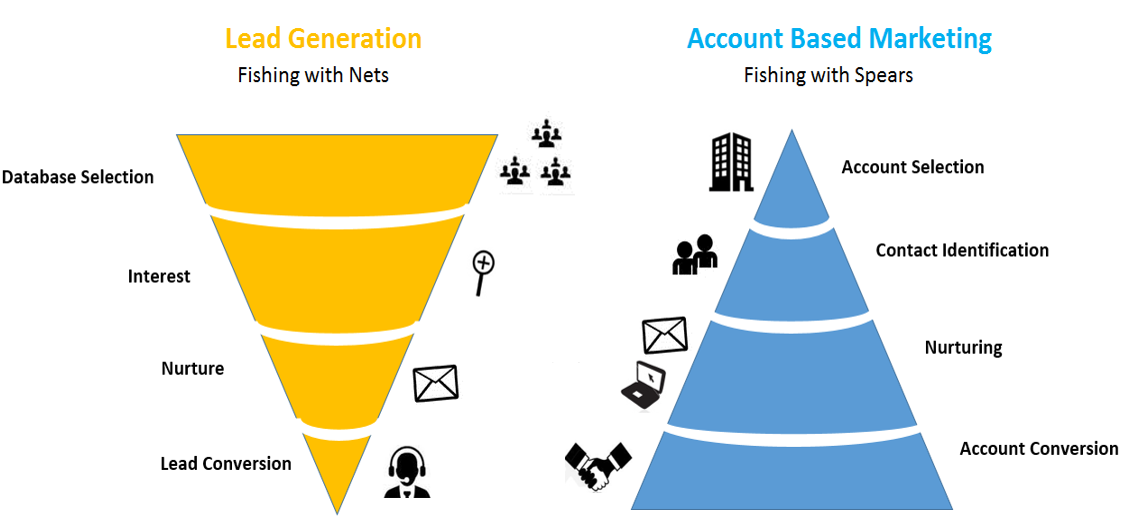What is B2B Intent Data? Types, Features, and Use Cases
B2B intent data is quickly becoming a must-have for any B2B marketer that wants to stay competitive in the ever-changing digital landscape. With so much data available, it can be hard to know which type of data to choose and how to use it most effectively. According to a recent study, 99% of large corporations now use intent data and monitoring tools, up from 25% in 2017. B2B Intent data can play an essential role in helping businesses understand the needs and wants of their audience.
With intent data, businesses can better understand clients' business needs, leading to improved client experience and increased sales. It gives the marketing and sales team data on client behavior and keeps them updated as they develop a product strategy.
In this blog post, we’ll take a look at what B2B intent data is, what types are available, its features and capabilities, as well as some potential use cases.
What is Intent Data?
Intent Data is an invaluable tool for businesses to understand the needs and interests of their clients. Information collected from online user behavior can be used to identify a user's intentions and interests. This data can be used to create more relevant content, personalize marketing messages, and provide the client with a better overall experience.

Knowing what your clients need and want allows businesses to create more meaningful client relationships and better understand client expectations. Intent Data can also be used to determine the effectiveness of marketing campaigns, allowing businesses to create more successful campaigns in the future to gain client loyalty.
How is Buyer Intent Data Collected?
Intent data is becoming increasingly crucial for businesses in today's competitive market. It is the information collected about a client's intent to buy a product or service. This data is collected through a variety of channels and sources, such as
- web analytics
- social media
- search engine data
- website visits
- product reviews
- surveys etc.
- natural language processing
- machine learning
- data mining,
Buyer intent data is collected in real-time and provides valuable insights into the client's buying journey and behavioral patterns. You can use this behavioral data to determine which products and services are most likely to be purchased and which channels and messages are most effective in reaching such potential buyers. By utilizing buyer intent data, you can better understand your clients or prospects and create more tailored experiences that will keep them engaged and coming back for more.
Who Can Intent Data Benefit?
The framework of intent data is built using business intelligence that employs machine learning techniques to discover insights, new patterns, engagement levels, and relationships in data. According to research, the average B2B buyer spends 67 percent of the buyer journey digitally, and the challenge here is finding these buyers before they choose an alternative solution. With the help of intent data, you can face such challenges head-on.
Sales And Marketing Teams
Your sales and marketing teams can identify and prioritize leads for a specific product strategy campaign by leveraging firmographic and intent data. Firmographic data helps segment the target audience, followed by identifying intent, which is the first step to leveraging first-party intent data. This first-party intent data then use personalization to create targeted messages that truly resonate with your clients. This first-party Intent data can assist sales teams in determining their clients' and prospects' level of interest. This allows you to make a lasting impression on the target client, build stronger relationships with them, and score above your competitors.
Understanding client intent allows you to measure the effectiveness of your campaigns and optimize your product strategy. This allows you to ensure that their messages reach and target the appropriate people. Furthermore, through content consumption evaluation, intent data can assist sales teams in tracking and measuring the impact of their campaigns, allowing them to optimize their strategies accordingly.
Intent Data can also be used to discover new opportunities for client engagement and growth. You can score leads more accurately and segment your list for more targeted marketing by understanding which companies are researching which products or services to address their challenges.
Agencies
Agencies are always looking for ways to understand better their target audience and the needs of their clients. Intent data is a valuable tool that can help agencies create more personalized campaigns, better understand client intent, and create more accurate forecasts.
Intent data can be used to track how clients interact with a brand's website, how frequently they browse content, and social media accounts. This data can help agencies make better-informed decisions about their campaigns and target audiences. Agencies can use intent data to identify emerging trends and trends in the industry, as well as to find the right audience for their campaigns and create more effective messaging.
Publishers
Content reigns supreme in today's digital media landscape. Publishers must understand what topics and content their readers are interested in to stay ahead of the competition, keep readers engaged, and improve content consumption. Publishers can use intent data to create more relevant, resonating content.
Publishers can use intent data to determine which content formats are most successful for specific audiences and tailor their content accordingly. Intent data can also be used to discover new topics and trends that could be explored in future content. With actionable insights, publishers can create content that their readers will love and keep them coming back for more.
Types of B2B Intent Data
There are three types of B2B intent data: explicit, implicit, and derived.
Explicit Intent Data
Explicit intent data is the information collected from potential clients who actively share with you data via the form on your website. This type of data is highly accurate, but it’s also limited in scope since not everyone who visits your site will take the time to fill out a form.
Implicit Intent Data
Implicit intent data is information that potential clients share indirectly, such as what keywords they are actively researching or what websites they visit. This type of data can be less accurate than explicit data since it’s based on indirect signals, but it can give you a broader view of the client's engagement.
Derived Intent Data
Derived intent data combines explicit and implicit data to give you the complete picture of a client's behavior. This data type is the most accurate but can be more challenging than explicit or implicit data alone.
Use Cases of B2B Intent Data
B2B intent data can be used several ways to improve marketing and sales strategies. Here are some everyday use cases:
Create Targeted ABM Programs
ABM is a hot topic in B2B marketing right now, and for a good reason - it works. Using B2B intent data, you can identify the accounts that are most likely to buy from you and create targeted programs specifically for them.
ABM, or account-based marketing with intent data, is a targeted approach to B2B marketing focusing on key accounts with the greatest potential for revenue growth. By identifying and targeting high-value accounts, ABM can help you close more deals and grow your business.

Targeted Advertising
Using data to identify which accounts are most likely to convert, you can target them with personalized ads across various channels (including display, social, and search).
Account-Based Landing Pages
Creating dedicated landing pages for each key account can help you better align your content with their business needs and interests.
Personalized Communications
From email campaigns to direct mail and even sales calls, personalizing your communications for each critical account can help you break through the noise and build relationships.
Events and Webinars
Hosting events and webinars tailored to your key accounts can help you build thought leadership and generate leads from these important clients. By understanding the account's buying journey and what they're interested in, you can better align your sales pitches and increase the likelihood of winning the deal.
Programmatic Ads
Programmatic ads are online advertising that uses computer-generated algorithms to purchase ad space in real time. This allows advertisers to target specific audiences with laser precision and avoid wasting money on ads that their target consumers will never see.
People respond to content when they relate to them. Consider this consumer example where an ad for women's clothing is shown to men. Here the chances of the ad being clicked drop to 20%. However, if the same ad is shown to the intent data of women, engagement is likely to increase to 80%.
Programmatic advertising has been a game-changer for the online advertising industry, making it easier for businesses of all sizes to compete for ad space and get their message in front of the right people at the right time.
Content Marketing
Intent data-based content marketing is creating and distributing valuable, relevant, actionable, and engaging content to attract and retain a clearly defined audience and, ultimately, to drive profitable client action.
It’s an ongoing effort that requires planning, creation, distribution, and measurement. And it’s not easy. But when done right, it can be an extremely effective way to build awareness, generate leads, nurture prospects, and even close deals. Sponsored content is usually created by a brand but published on a third-party site, such as a company blog post on Forbes.com. The goal is to get the brand’s name in front of a new audience.
How Does Intent Data Differ from Other Web Tracking Data?
Unlike other web tracking data, which is usually collected over time and applies to a larger group of people or companies, intent data is tailored to a specific user or company and is collected in real-time. This makes intent data more accurate and actionable based on individual user behavior.
Intent data is often used to inform marketing decisions, such as which offers to present to a user or what type of content to feature in an email campaign. On the other hand, web tracking data is typically used for analytics purposes. While both types of data provide valuable insights about user behavior, intent data is gathered from the user’s digital footprint and can provide more detailed insights into user preferences and interests.
Conclusion
For businesses looking to gain deeper insights into their target audience, intent data can be valuable. Understanding the account's buying journey and what they're interested in will help you better align your sales pitches and increase your chances of closing the deal. To learn more about intent data and how to leverage a data-driven lead generation strategy, schedule some time here to talk to us at S2W Media.
_MI-Jul-21-2025-12-05-24-8609-PM.png?width=1600&height=1000&name=63dbb9e116846d3e66f58437_MicrosoftTeams-image%20(119)_MI-Jul-21-2025-12-05-24-8609-PM.png)

